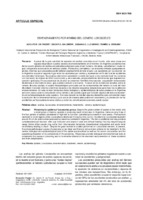Please use this identifier to cite or link to this item:
http://sgc.anlis.gob.ar/handle/123456789/68| DC Field | Value | Language |
|---|---|---|
| dc.contributor.author | de Roodt, Adolfo R. | es |
| dc.contributor.author | Salomón, Oscar Daniel | es |
| dc.contributor.author | Lloveras, Susana C. | es |
| dc.contributor.author | Orduna, Tomás A. | es |
| dc.date.accessioned | 2012-09-20T16:12:15Z | - |
| dc.date.available | 2012-09-20T16:12:15Z | - |
| dc.date.issued | 2002 | - |
| dc.identifier.issn | 0025-7680 | - |
| dc.identifier.uri | http://sgc.anlis.gob.ar/handle/123456789/68 | - |
| dc.identifier.uri | http://www.medicinabuenosaires.com/revistas/vol62-02/1/v62_n1_p83_94.pdf | - |
| dc.description | Fil: De Roodt, Adolfo R. ANLIS Dr.C.G.Malbrán. Instituto Nacional de Producción de Biológicos; Argentina. | es |
| dc.description | Fil: Salomón, Oscar R. ANLIS Dr.C.G.Malbrán. Centro Nacional de Diagnóstico e Investigación en Endemo-Epidemias; Argentina. | es |
| dc.description | Fil: Lloveras, Susana S. Hospital de Enfermedades Infecciosas Francisco J. Muñiz. Centro Municipal de Patología Regional Argentina y Medicina Tropical; Argentina. | es |
| dc.description | Fil: Orduna, Tomás A. Hospital de Enfermedades Infecciosas Francisco J. Muñiz. Centro Municipal de Patología Regional Argentina y Medicina Tropical; Argentina. | es |
| dc.description.abstract | Despite the great number of spiders in the world, only a small group of them is capable of producing death in humans. In Argentina, there are only three of the four genera of spiders considered of high risk to humans: Latrodectus is present in rural areas, Phoneutria is restricted to small regions while Loxosceles is distributed throughout the country. Accidents by Loxosceles represent around 4% of the total number produced by venomous animals in Argentina. The bite is accidental and may produce considerable local necrosis with scar formation and ulcers of slow and difficult healing that may require surgical repair. Some bitten people may suffer from intravascular hemolysis, disseminated coagulation and acute renal insufficiency leading to death. Despite the great number of studies performed on Loxosceles venoms, at present, the physiopathological course of poisoning is not clear and there is not common criteria for its treatment. In this review, biological and epidemiological data of this spider are described as well as the venom composition and the possible participation of its components in the poisoning. These data provide biological and biochemical tools to understand the course of poisoning and to have better criteria for the treatment and prevention of these accidents and their complications. | es |
| dc.format | application/pdf | ES |
| dc.format | - | |
| dc.language.iso | es | es |
| dc.relation | datasets | - |
| dc.relation.ispartof | Medicina (Buenos Aires) | es |
| dc.relation.uri | http://creativecommons.org/licenses/by/4.0/ | - |
| dc.rights | Open Access | - |
| dc.source | Medicina (Buenos Aires) 2002; 62(1): 83–94 | en_US |
| dc.subject | Hidrolasas Diéster Fosfóricas | es |
| dc.subject | Venenos de Araña | es |
| dc.subject | Arañas | es |
| dc.subject | Envenenamiento | es |
| dc.subject | Venenos | es |
| dc.subject | Epidemiología | es |
| dc.title | Envenenamiento por arañas del genero loxosceles | es |
| dc.title.alternative | Poisoning by spiders of Loxosceles genus | es |
| dc.type | Artículo | es |
| dc.rights.license | Creative Commons Attribution 4.0 International License | - |
| anlis.essnrd | 1 | es |
| item.fulltext | With Fulltext | - |
| item.openairecristype | http://purl.org/coar/resource_type/c_18cf | - |
| item.openairetype | Artículo | - |
| item.grantfulltext | open | - |
| item.languageiso639-1 | es | - |
| item.cerifentitytype | Publications | - |
| crisitem.author.dept | Administración Nacional de Laboratorios e Institutos de Salud “Dr. Carlos G. Malbrán” (ANLIS) | - |
| crisitem.author.dept | Instituto Nacional de Producción de Biológicos (INPB) | - |
| crisitem.author.dept | Administración Nacional de Laboratorios e Institutos de Salud “Dr. Carlos G. Malbrán” (ANLIS) | - |
| crisitem.author.dept | Instituto Nacional de Medicina Tropical (INMeT) | - |
| crisitem.author.parentorg | Administración Nacional de Laboratorios e Institutos de Salud “Dr. Carlos G. Malbrán” (ANLIS) | - |
| crisitem.author.parentorg | Administración Nacional de Laboratorios e Institutos de Salud “Dr. Carlos G. Malbrán” (ANLIS) | - |
| Appears in Collections: | snrd Publicaciones CeNDIE Publicaciones INPB | |
Files in This Item:
| File | Description | Size | Format | |
|---|---|---|---|---|
| Medicina (Buenos Aires), 2002, 62(1), 83–94..pdf | 253.59 kB | Adobe PDF |  View/Open |
Page view(s)
543
checked on Jan 5, 2026
Download(s)
247
checked on Jan 5, 2026
Google ScholarTM
Check
Items in DSpace are protected by copyright, with all rights reserved, unless otherwise indicated.

